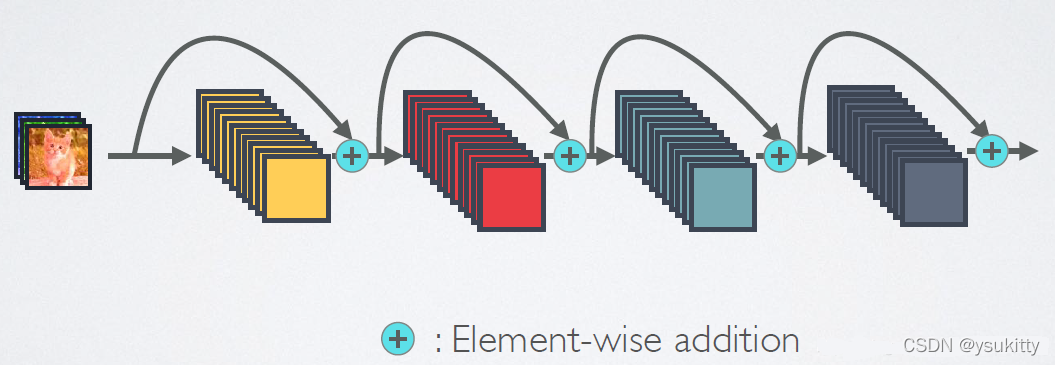2017-DenseNet CVPR
论文链接:https://arxiv.org/abs/1608.06993
代码的github链接:https://github.com/liuzhuang13/DenseNet感谢我的研究生导师!!!
1. 简介
文章是CVPR2017的oral。论文中提出的DenseNet主要还是和ResNet及Inception网络做对比,思想上有借鉴,但却是全新的结构,网络结构并不复杂,却非常有效,在CIFAR指标上全面超越ResNet。
DenseNet脱离了加深网络层数(ResNet)和加宽网络结构(Inception)来提升网络性能的定式思维,从特征的角度考虑,通过特征重用和旁路(Bypass)设置,既大幅度减少了网络的参数量,
DenseNet论文中本身引入太多公式,所以仅对其进行总结。作者则是从feature入手,通过对feature的极致利用达到更好的效果和更少的参数。
特点
(1).减轻梯度消失(vanishing-gradient)。
(2).加强feature传递。
(3).鼓励特征重用(encourage feature reuse)。
(4).较少的参数数量。
2. 网络
2.1 稠密连接
基础结构为Res Block在每一个Dense Block中,任何两层之间都有直接的连接。通过密集连接,缓解梯度消失问题,加强特征传播,鼓励特征复用,极大的减少了参数量。
看下图可以看到,
- ResNet是每个层与前面的某层(一般是2~3层)短路连接在一起,连接方式是通过元素级相加。
- 而在DenseNet中,每个层都会与前面所有层在channel维度上连接(concat)在一起(这里各个层的特征图大小是相同的,后面会有说明),并作为下一层的输入。
- 对于一个 L L L层的网络,DenseNet共包含 L ( L + 1 ) 2 \frac{L(L+1)}{2} 2L(L+1)?个连接,相比ResNet,这是一种密集连接。而且DenseNet是直接concat来自不同层的特征图,这可以实现特征重用,提升效率,这一特点是DenseNet与ResNet最主要的区别。


图1为ResNet网络的短路连接机制(其中+代表的是元素级相加操作),作为对比,图2为DenseNet网络的密集连接机制(其中c代表的是channel级连接操作)。
如果用公式表示的话,传统的网络在 L L L层的输出为
x l = H l ( x l ? 1 ) x_l=H_l(x_{l-1}) xl?=Hl?(xl?1?)
而对于ResNet,增加了来自上一层输入的identity函数:
x l = H l ( x l ? 1 ) + x l ? 1 x_l=H_l(x_{l-1})+x_{l-1} xl?=Hl?(xl?1?)+xl?1?
在DenseNet中,会连接前面所有层作为输入:
x l = H l [ x 0 , x 1 , ? ? , x l ? 1 ] x_l=H_l[x_0,x_1,\cdots,x_{l-1}] xl?=Hl?[x0?,x1?,?,xl?1?]
其中,上面的 H l ( ? ) H_l(\cdot) Hl?(?)代表是非线性转化函数(non-linear transformation),它是一个组合操作,其可能包括一系列的BN(Batch Normalization),ReLU,Pooling及Conv操作。注意这里的 l l l层与 l ? 1 l-1 l?1层之间可能实际上包括多个卷积层。
DenseNet的前向过程如图3所示,可以更直观地理解其密集连接方式,比如 h 3 h_3 h3?的输入不仅包括来自 h 2 h_2 h2?的 x 2 x_2 x2?,还包括前面两层的 x 1 x_1 x1?和 x 2 x_2 x2?,它们是在channel维度上连接在一起的。

2.2 Transition
CNN网络一般要经过Pooling或者stride>1的Conv来降低特征图的大小,而DenseNet的密集连接方式需要特征图大小保持一致。为了解决这个问题,DenseNet网络中使用DenseBlock+Transition的结构,其中DenseBlock是包含很多层的模块,每个层的特征图大小相同,层与层之间采用密集连接方式。而Transition模块是连接两个相邻的DenseBlock,并且通过Pooling使特征图大小降低。图4给出了DenseNet的网路结构,它共包含4个DenseBlock,各个DenseBlock之间通过Transition连接在一起。

2.3 总体架构
主要包含DenseBlock和transition layer两个组成模块。其中Dense Block为稠密连接的highway的模块,transition layer为相邻2个Dense Block中的那部分。

3. 代码
import math
import torch
import torch.nn as nn
import torch.nn.functional as F
import torch.utils.checkpoint as cp
from collections import OrderedDict
def _bn_function_factory(norm, relu, conv):
def bn_function(*inputs):
concated_features = torch.cat(inputs, 1)
bottleneck_output = conv(relu(norm(concated_features)))
return bottleneck_output
return bn_function
class _DenseLayer(nn.Module):
def __init__(self, num_input_features, growth_rate, bn_size, drop_rate, efficient=False):
super(_DenseLayer, self).__init__()
self.add_module('norm1', nn.BatchNorm2d(num_input_features)),
self.add_module('relu1', nn.ReLU(inplace=True)),
self.add_module('conv1', nn.Conv2d(num_input_features, bn_size * growth_rate,
kernel_size=1, stride=1, bias=False)),
self.add_module('norm2', nn.BatchNorm2d(bn_size * growth_rate)),
self.add_module('relu2', nn.ReLU(inplace=True)),
self.add_module('conv2', nn.Conv2d(bn_size * growth_rate, growth_rate,
kernel_size=3, stride=1, padding=1, bias=False)),
self.drop_rate = drop_rate
self.efficient = efficient
def forward(self, *prev_features):
bn_function = _bn_function_factory(self.norm1, self.relu1, self.conv1)
if self.efficient and any(prev_feature.requires_grad for prev_feature in prev_features):
bottleneck_output = cp.checkpoint(bn_function, *prev_features)
else:
bottleneck_output = bn_function(*prev_features)
new_features = self.conv2(self.relu2(self.norm2(bottleneck_output)))
if self.drop_rate > 0:
new_features = F.dropout(new_features, p=self.drop_rate, training=self.training)
return new_features
class _Transition(nn.Sequential):
def __init__(self, num_input_features, num_output_features):
super(_Transition, self).__init__()
self.add_module('norm', nn.BatchNorm2d(num_input_features))
self.add_module('relu', nn.ReLU(inplace=True))
self.add_module('conv', nn.Conv2d(num_input_features, num_output_features,
kernel_size=1, stride=1, bias=False))
self.add_module('pool', nn.AvgPool2d(kernel_size=2, stride=2))
class _DenseBlock(nn.Module):
def __init__(self, num_layers, num_input_features, bn_size, growth_rate, drop_rate, efficient=False):
super(_DenseBlock, self).__init__()
for i in range(num_layers):
layer = _DenseLayer(
num_input_features + i * growth_rate,
growth_rate=growth_rate,
bn_size=bn_size,
drop_rate=drop_rate,
efficient=efficient,
)
self.add_module('denselayer%d' % (i + 1), layer)
def forward(self, init_features):
features = [init_features]
for name, layer in self.named_children():
new_features = layer(*features)
features.append(new_features)
return torch.cat(features, 1)
class DenseNet(nn.Module):
r"""Densenet-BC model class, based on
`"Densely Connected Convolutional Networks" <https://arxiv.org/pdf/1608.06993.pdf>`
Args:
growth_rate (int) - how many filters to add each layer (`k` in paper)
block_config (list of 3 or 4 ints) - how many layers in each pooling block
num_init_features (int) - the number of filters to learn in the first convolution layer
bn_size (int) - multiplicative factor for number of bottle neck layers
(i.e. bn_size * k features in the bottleneck layer)
drop_rate (float) - dropout rate after each dense layer
num_classes (int) - number of classification classes
small_inputs (bool) - set to True if images are 32x32. Otherwise assumes images are larger.
efficient (bool) - set to True to use checkpointing. Much more memory efficient, but slower.
"""
def __init__(self, growth_rate=12, block_config=(16, 16, 16), compression=0.5,
num_init_features=24, bn_size=4, drop_rate=0,
num_classes=10, small_inputs=True, efficient=False):
super(DenseNet, self).__init__()
assert 0 < compression <= 1, 'compression of densenet should be between 0 and 1'
# First convolution
if small_inputs:
self.features = nn.Sequential(OrderedDict([
('conv0', nn.Conv2d(3, num_init_features, kernel_size=3, stride=1, padding=1, bias=False)),
]))
else:
self.features = nn.Sequential(OrderedDict([
('conv0', nn.Conv2d(3, num_init_features, kernel_size=7, stride=2, padding=3, bias=False)),
]))
self.features.add_module('norm0', nn.BatchNorm2d(num_init_features))
self.features.add_module('relu0', nn.ReLU(inplace=True))
self.features.add_module('pool0', nn.MaxPool2d(kernel_size=3, stride=2, padding=1,
ceil_mode=False))
# Each denseblock
num_features = num_init_features
for i, num_layers in enumerate(block_config):
block = _DenseBlock(
num_layers=num_layers,
num_input_features=num_features,
bn_size=bn_size,
growth_rate=growth_rate,
drop_rate=drop_rate,
efficient=efficient,
)
self.features.add_module('denseblock%d' % (i + 1), block)
num_features = num_features + num_layers * growth_rate
if i != len(block_config) - 1:
trans = _Transition(num_input_features=num_features,
num_output_features=int(num_features * compression))
self.features.add_module('transition%d' % (i + 1), trans)
num_features = int(num_features * compression)
# Final batch norm
self.features.add_module('norm_final', nn.BatchNorm2d(num_features))
# Linear layer
self.classifier = nn.Linear(num_features, num_classes)
# Initialization
for name, param in self.named_parameters():
if 'conv' in name and 'weight' in name:
n = param.size(0) * param.size(2) * param.size(3)
param.data.normal_().mul_(math.sqrt(2. / n))
elif 'norm' in name and 'weight' in name:
param.data.fill_(1)
elif 'norm' in name and 'bias' in name:
param.data.fill_(0)
elif 'classifier' in name and 'bias' in name:
param.data.fill_(0)
def forward(self, x):
features = self.features(x)
out = F.relu(features, inplace=True)
out = F.adaptive_avg_pool2d(out, (1, 1))
out = torch.flatten(out, 1)
out = self.classifier(out)
return out
if __name__ == '__main__':
# from torchsummary import summary
#
# device = torch.device('cuda' if torch.cuda.is_available() else 'cpu')
# model = convnext_tiny(num_classes=5)
# model.to(device)
# print(model)
# x = torch.randn(1,3,224,224,device=device)
# y = model(x)
# print(y)
# summary(model, input_size=(3, 224, 224))
# from torchvision.models import
from thop import profile
model =DenseNet(num_classes=1000)
input = torch.randn(1, 3, 224, 224)
flops, params = profile(model, inputs=(input,))
print("flops:{:.3f}G".format(flops/1e9))
print("params:{:.3f}M".format(params/1e6))
from torchvision.models import densenet121
参考资料
